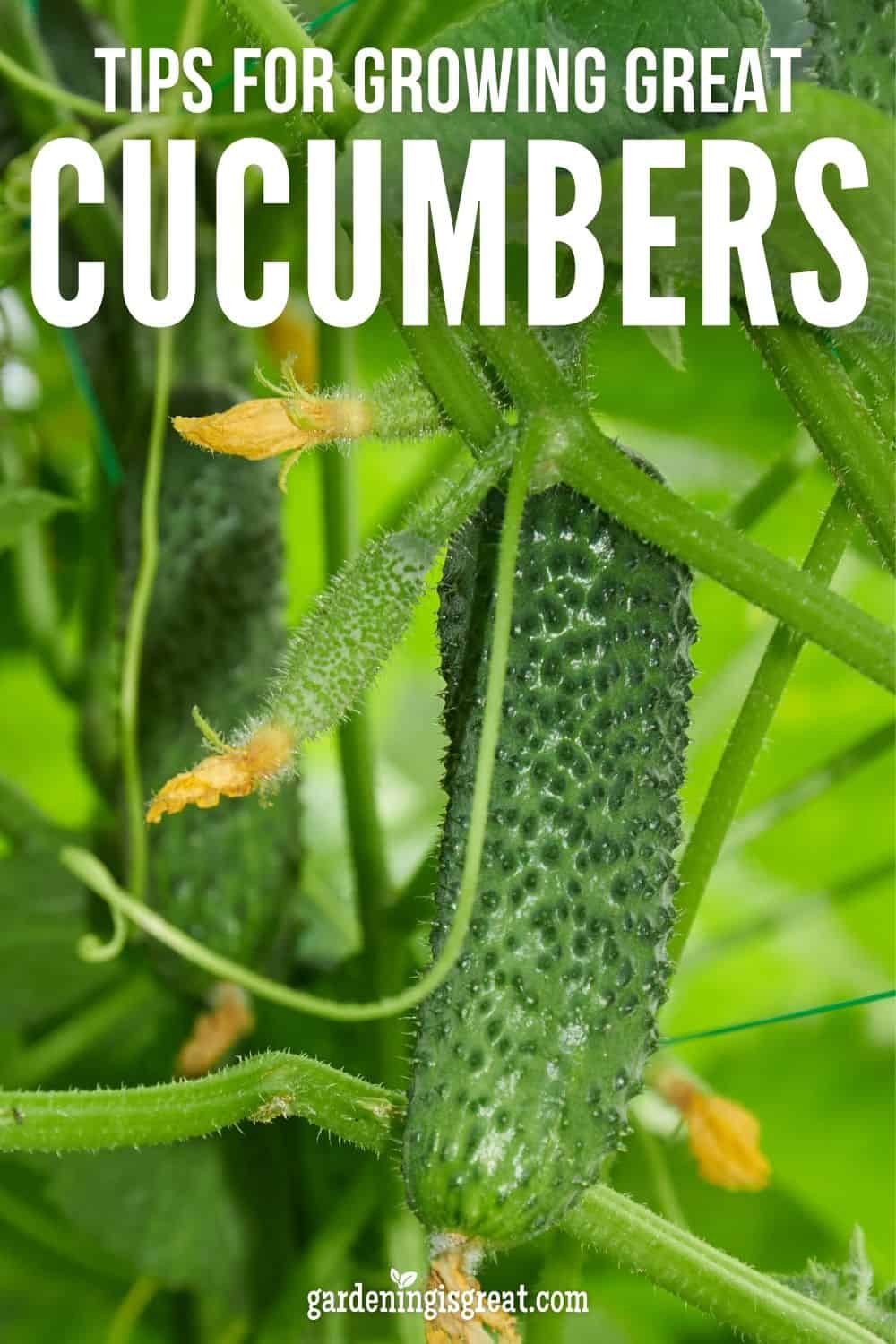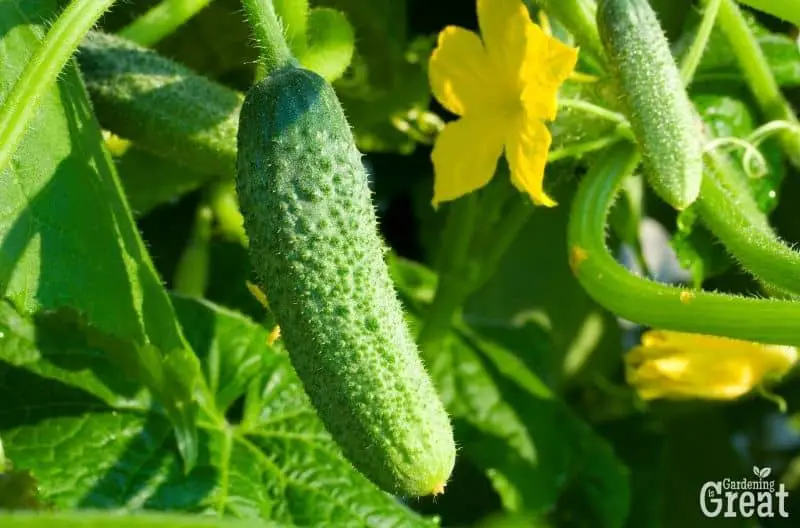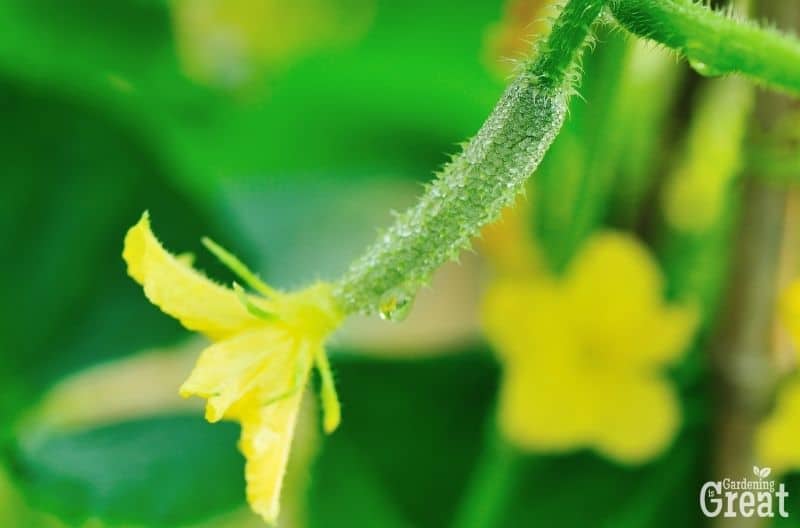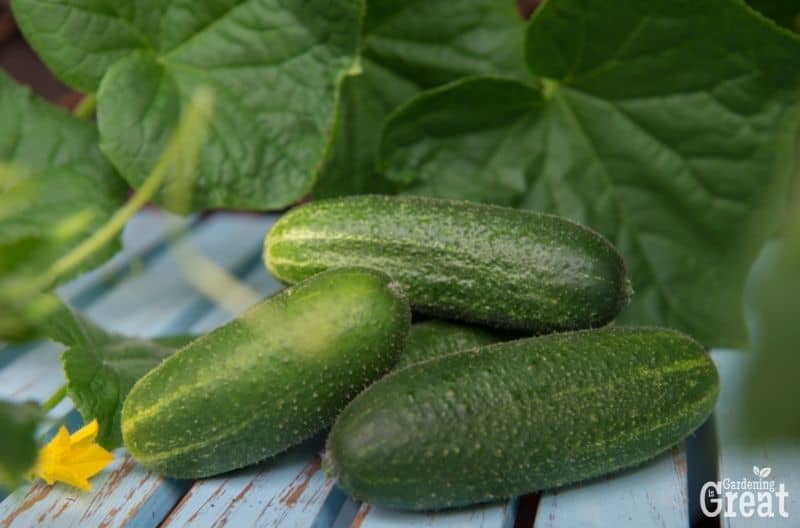13 Top Tips for Growing Great Cucumbers
This post may contain affiliate links. Please see the privacy policy for details.
Cucumbers are a common crop for backyard gardens, but they can be tricky to grow. Most other plants will grow well even in less than ideal conditions, but cucumbers are more fickle.
Cucumbers are picky about their growing conditions. They need the right amount of water and sun exposure, and they are even picky about the soil in which they are planted.
Here are our best secrets and tips for growing a great crop of cucumbers that you can enjoy fresh from the garden or use to make pickles.

The Best Soil for Cucumbers
Before you plant your cucumbers, take time to prep the soil. Cucumbers like light soil that has a lot of drainage.
If you have sandy soil, expect an earlier cucumber crop than if you have clay or loam soil. You’ll get a later crop in clay soil, but you’ll get a higher yield.
No matter which type of soil you have, cucumbers love compost. About a month before you plan to plant, add compost or manure to the soil and till it. As you plant your cucumbers, add a shovel full of compost to each mound. Not only does compost add nutrients that the plants need, but it also helps improve drainage.
Cucumbers like the soil pH between 5.5 and 7. A higher pH can help decrease the chance of a fungal infection. Test your soil and make adjustments as necessary.
Choose Your Cucumbers
There are several kinds of cucumbers, so you’ll want to choose varieties that are good for your intended use (e.g., canning or eating raw). However, you’ll also want to choose varieties that are more resistant to diseases and pests.
For eating raw, try Marketmore 76, Marketmore 80, or salad bush. For pickles, try regal cucumbers.
Choosing a Location
Cucumbers are rather finicky about the amount of sun that they get. They like heat in the morning and shade in the evening.

For best results, plant cucumbers on the east side of your garden. They will get the morning sun, which will dry out the plants and lessen the chance of mildew.
Plant sunflowers or something tall on the west side of the cucumbers. They will provide shade for your cucumbers in the evening.
Crop Rotation
It’s best to choose a new location for your cucumbers each year as cucumbers can develop diseases in the soil. If you plant them in the same space the following year, you risk your plants getting a disease.
You’ll also want to avoid planting them where you planted similar plants like pumpkins, melons, or squash. These plants also attract the same soil microbes, which can harm your cucumbers.
For best results, wait three years before planting cucumbers in the same location.
Pollinators
Cucumbers aren’t great at direct pollination. You can encourage pollination by attracting pollinating insects to that area of your garden.

Plant dill or sunflowers next to your cucumbers. This helps provide evening shade, and they attract pollinators.
You can also plant lemon balm, comfrey, chives, and other pollinator-attracting herbs next to your cucumbers.
Seeds Versus Starts
You can plant cucumber seeds directly in the garden or transplant young starts. For best results, either buy young plants or start your seeds indoors and transplant them into the garden.
Planting a stronger young plant helps protect it from beetles and diseases.
Planting
Cucumbers can rot if they get too wet. To help combat this, create mounds in which to plant your cucumbers. These mounds help protect the stem of the plant so it doesn’t sit in standing water after rain.

Create mounds with an 18-inch diameter and about 4 inches high in the center. Don’t forget to add your compost to each mound.
Companion Planting
Other plants can help protect your cucumber plants. We already mentioned planting next to sunflowers and dill for shade and pollination, but there are other plants that can help your cucumbers.
Plant one radish seed with each cucumber plant. The radish will help keep beetles at bay. Don’t harvest these radishes; let them flower and don’t pick them.
You can also interplant your cucumber row with beans, peas, or lettuce. These help offer protection for your cucumbers.
Don’t plant cucumbers near aromatic herbs like basil or oregano. Also don’t plant them next to sage because sage will make your cucumbers smaller.
If you plant potatoes, don’t put them near your cucumbers. Cucumbers can make it more likely that your potatoes will be afflicted with blight.
Vertical Gardens
Cucumbers spread out, but this can make them more susceptible to microbes in the soil and to water rot.
You can use a trellis to encourage cucumbers to grow vertically. This helps them dry out quicker during the day, which reduces mildew and other microbes.
Watering
Cucumbers like just the right amount of water. If they are too dry, the leaves will start to wilt. This can cause stress for the plant, making them more susceptible to diseases.
However, too much water can lead to fungal growth. It’s important to water the base of the plant and not the leaves if you water your garden.
Mulch
Weeds can overcrowd your cucumbers and reduce airflow. Weeds can also attract beetles and other pests to your garden.

Use mulch around our cucumber plants. This keeps weeds down and keeps the soil moist to keep the water levels consistent.
Fertilizing
Cucumbers can benefit from fertilizer throughout the growing season. Use compost tea or an organic fertilizer every two weeks until you start to see cucumbers.
Harvesting
Hopefully, these cucumbers tips and tricks will lead to a bumper crop. In late summer, it’s time to harvest your cucumbers.
Pick cucumbers daily to make them more productive. Cucumbers are ready to pick when they are 6 inches long for slicing cucumbers and 3 inches long for pickling cucumbers.

Cucumbers aren’t the easiest crop to grow but don’t be afraid to try them in your backyard garden. With these tips and tricks, you’ll be able to successfully grow cucumbers for eating or for canning.
And for more vegetable-growing tips, be sure to read these next:
